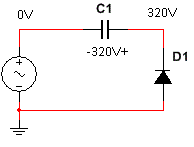I attached a picture of the Villard circuit bellow. I can't seem to understand why the capacitor stays charged-up. Since I = CdV/dt, a capacitor finishes being charged at the crests of the voltage sine wave. A capacitor alone would then begin uncharging (see the second picture). The thing that is confusing me is that for the Villard, after the peak voltage, the voltage is obviously still positive (since the voltage and current are 90 degrees out of phase). Wouldn't this mean that the diode is forward-biased? Isn't it supposed to act like a plain conductor when it is forward-biased? If so then why doesn't the capacitor just discharge through it? BTW with the voltage and current 90 degrees out of phase, the current can flow in both directions when the voltage is above zero, right? (One direction while voltage is rising, the other while it is falling).
Perhaps the explanation is that a diode only lets current flow in one direction, if it is forward biased too.
Obviously this goes toward understanding the fundamentals. Feel free to throw what you like at me.












